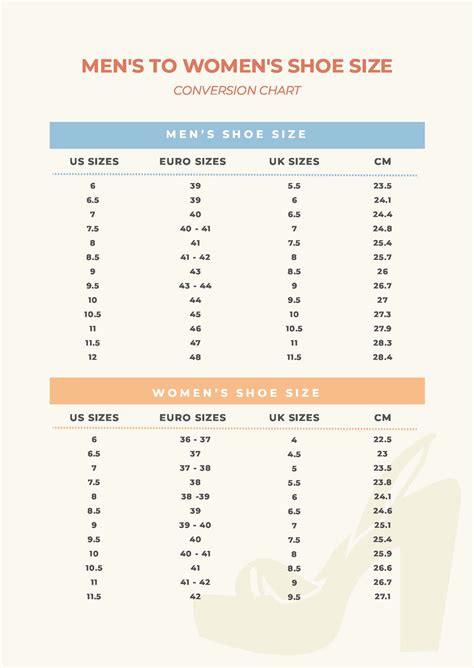5 Shoe Size Tips

When it comes to shoe size, finding the perfect fit can be a challenge for many of us. Whether you’re shopping online or in-store, it’s easy to end up with shoes that are either too tight or too loose, which can lead to discomfort, pain, and even long-term foot problems. In this article, we’ll explore five essential shoe size tips to help you navigate the complex world of footwear and find the ideal fit for your feet.
1. Measure Your Feet Regularly
One of the most common mistakes people make when buying shoes is not measuring their feet regularly. Foot size can change over time due to various factors such as age, weight gain or loss, and even hormonal changes. It’s recommended to measure your feet at least once a year, preferably in the afternoon, as feet tend to swell slightly during the day. Use a Brannock device, found in most shoe stores, or trace your foot on a piece of paper to get an accurate measurement. Remember, the size of your left and right foot might not be identical, so ensure to measure both feet and go with the larger size to ensure a comfortable fit.
2. Consider the Type of Shoe
Different types of shoes are designed with unique features that can affect fit. For example, running shoes often have a more snug fit to provide support during movement, while dress shoes might have a more streamlined, tighter fit. Understanding the specific design and intended use of the shoe can help you adjust your size expectations. Additionally, some shoes, like sneakers, may have a more forgiving fit due to their materials and construction, whereas leather dress shoes might require a break-in period. Being aware of these differences can help you choose the right size based on the shoe’s purpose and your personal comfort preferences.
3. Try Shoes On at the Right Time
The timing of when you try on shoes can significantly impact the perceived fit. As mentioned earlier, feet tend to swell throughout the day, so trying on shoes in the afternoon can give you a more accurate fit. Moreover, if you’re planning to wear the shoes with specific types of socks (e.g., thick athletic socks or thin dress socks), wear those when you try the shoes on to ensure the best fit. This attention to detail can make a substantial difference in how comfortable your shoes are in real-world use.
4. Don’t Rely Solely on Size Numbers
Shoe sizing can vary significantly between brands and even within different styles from the same brand. What might be a size 9 in one brand could fit like a size 8 or 10 in another. Instead of relying solely on the numerical size, pay attention to how the shoe feels on your foot. Check if you have about a half-inch (about the width of your finger) of space between your longest toe and the shoe’s end. This rule of thumb helps ensure that your toes have enough room to wiggle slightly, which is crucial for comfort and preventing issues like bunions or hammertoes.
5. Break In Your Shoes
Finally, understand that some shoes, especially those made from stiffer materials like leather, may require a break-in period. During this time, the shoe will mold to the shape of your foot, providing a more personalized fit. There are several ways to speed up the break-in process, including wearing the shoes around the house with thicker socks, using shoe stretchers, or applying leather conditioners to soften the material. Be patient, as rushing into wearing shoes that aren’t fully broken in can lead to blisters, discomfort, and a less-than-ideal fit.
Conclusion
Finding the right shoe size is a combination of accurate measurement, understanding shoe design, timing your try-ons correctly, not relying solely on numerical sizes, and sometimes, being patient through a break-in period. By following these tips, you can significantly improve your chances of finding shoes that fit perfectly, enhancing your comfort, performance, and overall satisfaction with your footwear. Remember, the perfect fit is not just about the size on the label but about how the shoe feels on your foot, so don’t hesitate to try different sizes, styles, and brands until you find the one that’s just right for you.
Frequently Asked Questions
How often should I measure my feet to ensure the best shoe fit?
+It's recommended to measure your feet at least once a year, as foot size can change due to various factors such as age, weight gain or loss, and hormonal changes. However, if you've experienced significant weight changes, pregnancy, or certain medical conditions, you might need to measure your feet more frequently.
<div class="faq-item">
<div class="faq-question">
<h3>Why do different shoe brands have varying sizes for what seems to be the same numerical size?</h3>
<span class="faq-toggle">+</span>
</div>
<div class="faq-answer">
<p>The difference in sizing between brands stems from variations in design, material, and manufacturing processes. Each brand might have its own lasts (the model form used to shape the shoe) and measurement standards, leading to discrepancies in how sizes are defined and fit. This is why it's essential to try on shoes from different brands to find the one that fits you best, rather than relying solely on the size number.</p>
</div>
</div>
<div class="faq-item">
<div class="faq-question">
<h3>How can I speed up the break-in process for new shoes?</h3>
<span class="faq-toggle">+</span>
</div>
<div class="faq-answer">
<p>To speed up the break-in process, consider wearing your new shoes around the house with thicker socks to stretch them slightly. You can also use shoe stretchers or apply leather conditioners to soften the material. In some cases, freezing a ziplock bag filled with water and placing it inside the shoe overnight can help stretch tight areas. Always check the manufacturer's recommendations for the best break-in methods, as some materials might require special care.</p>
</div>
</div>
</div>



